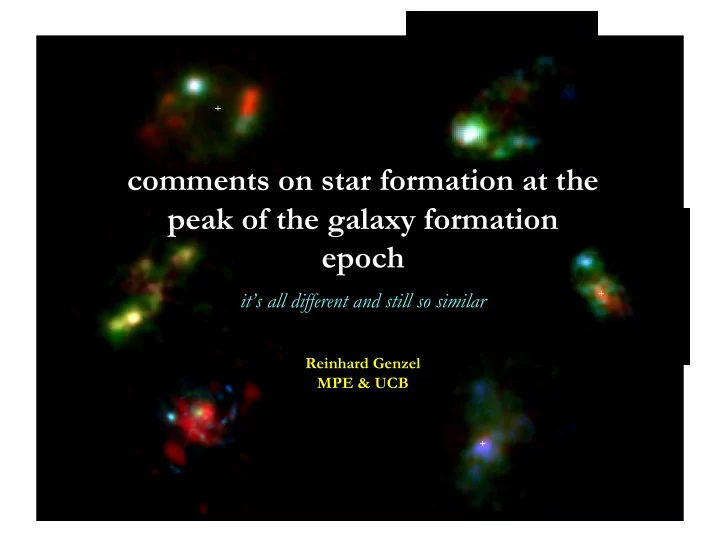

comments on star formation at the peak of the galaxy formation epoch it’s all different and still so similar Reinhard Genzel MPE & UCB
star formation and feedback at the peak of the galaxy formation epoch continuous LIRGs accretion from halo & disk instabilities ULIRGs extrapolation from (major) mergers z~0: high-z star & starbursts formation dominated by starbursts & mergers Soifer et al. 2008 Lilly et al. 1996, Steidel et al. 1996, Hopkins & Beacom 2006, Soifer et al. 2008, Rees & Ostriker 1977, Silk 1977, White & Rees 1978, Kauffmann et al. 1993, Steinmetz & Navarro 2003, Hernquist, Springel, di Matteo, Hopkins et al. 2003-2009, Robertson & Bullock 2008, Sanders & Mirabel 1996, Dekel & Birnboim 2003,2006, Keres et al. 2005, 2009, Nagamine et al. 2005, Davé 2007, Kitzbichler & White 2007, Naab et al. 2007, Governato et al. 2008, Ocvirk et al. 2008, Dekel et al. 2009, Agertz et al. 2009, Guo et al. 2009, Teyssier et al. 2010, Bournaud 2010, Davè et al. 2011a,b, Kauffmann et al. 2010
star formation in z~0 disk galaxies is inefficient & occurs in dense, extincted gas z~0 star forming galaxies have a low efficiency of star distance 130pc formation ε SF ; this may be the direct consequence of the small fraction of self-gravitating gas on small scales in a highly turbulent medium driven by feedback. As a result the ‘depletion’ time scale from molecular gas to stars is long Q~1 Pipe nebula t depletion ~ t dyn / ε SF ~10 9 yrs ρ Oph ~8x10 3 M , D=20pc ~1.4x10 4 M , D=20pc 21 YSOs 316 YSOs active star formation only occurs Krumholz ¡& ¡McKee ¡2005, ¡McKee ¡& ¡Ostriker ¡2008, ¡Bigiel ¡et ¡ in dense (>10 4 cm -3 ), highly obscured al. ¡2008, ¡Leroy ¡et ¡al. ¡2008, ¡Bauermeister ¡& ¡Blitz ¡2010, ¡ (A V >7) regions Bournaud ¡2011, ¡Saintonge ¡et ¡al. ¡2011 ¡ Lada, Alves, Lombardi 2006-2009 Rosetta cluster GMC: PACS & SPIRE
star formation rates across cosmic time AGN ¡powered ¡ HYLIRGs ¡ SMGs ¡ ULIRGs ¡ SDSS: Schiminovich et al. 2007 ¡ s t s r u b r a t s / s G R I L z~0 Noeske +07, Daddi+07, Elbaz+07 Tacconi, Daddi et al. 2010, 2011
galaxies on ‘star forming (main) sequence’ are disks with Σ star form & n Sersic increasing above sequence 6x10 5 galaxies 1x10 5 galaxies 2.5x10 4 galaxies Rodighiero et al. 2011 (PEP): off-ms galaxies account for ~10% of cosmic star SMGs SMGs formation at z~2 ULIRGs Wuyts et al. 2011 (PEP): SDSS/GALEX, COSMOS,GOODS
Galactic star formation in equilibrium with cosmic accretion Kere š et al. 2005, 2009, Neistein et al. 2006, Genel et al. 2008, Guo et al. 2009, Oppenheimer & Davè 2006, Dekel et al. 2009, Davè et al. 2010, 2011, Dutton et al. 2009, Bouchè et al. 2010
large clumps from fragmentation in gas-rich, Q ≤ 1 disks 2.1 ¡ 1.6 ¡ 1.3 ¡ R ~ 1kpc 1.1 ¡ 0.8 ¡ Q ¡ 0.4 ¡ 0.2 ¡ 5 kpc largest star formation clumps in high-z ‘main-sequence’ disks are the largest scale of gravitational fragmentation, scaled up to the 5-10 times greater gas fraction & 10 1.5…3 greater interstellar pressure than at z~0 Noguchi 1999, Immeli et al. 2004, Bournaud et al. 2007, Elmegreen et al. 2008, Dekel et al. 2009b, Genzel et al. 2008, 2011, Krumholz & Burkert 2010
properties of SF-regions change above main-sequence z>1 star formation rate (M yr -1 ) FIR line L [CII] 158 /L FIR deficits ms da Cunha et al. 2010 increasing ionization parameter U, or density n H log (M dust (M ) ) L FIR /M(H 2 ) (L /M ) Gracia-Carpio et al. 2010 Elbaz et al. 2010, 2011, Hwang et al. 2011, Nordon et al. 2010, 2011 main-sequence galaxies off-main-sequence galaxies across z have remarkably across z are warmer and uniform infrared spectral have much lower PAH energy distributions emission
star formation ‘above’ the main sequence
Recommend
More recommend